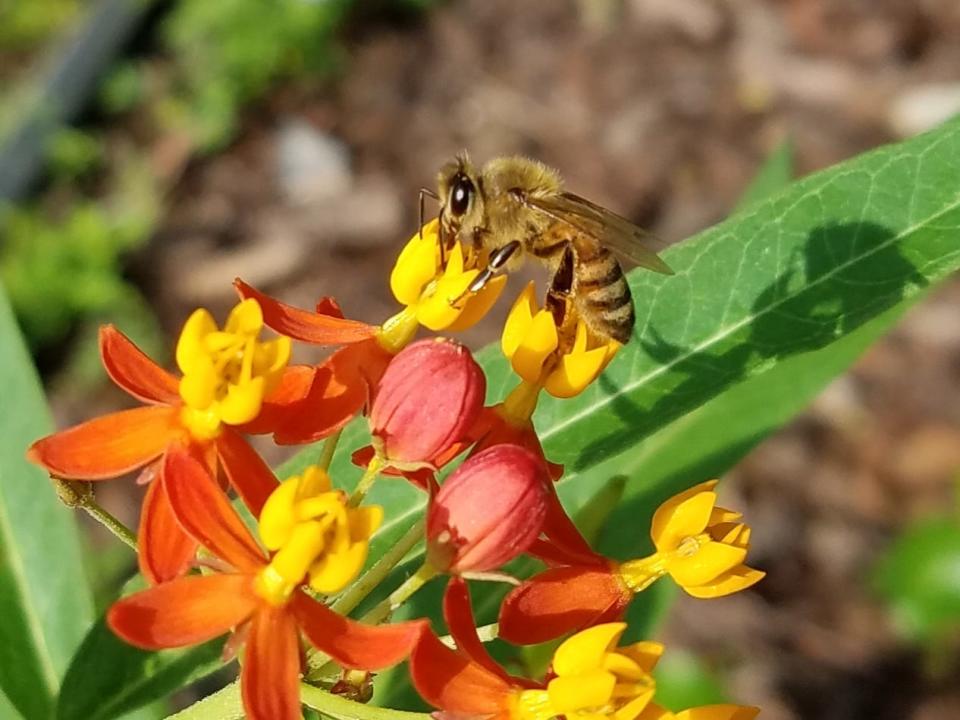Sweet! August means celebrating honey bees; here's how to them to you Space Coast yard
Support local journalism: Find offers for new subscribers here: Special Offers — FLORIDA TODAY.
Want to read our e-Edition? Here are some tips for getting the best experience.
Guess what? Aug. 20 is National Honey Bee Day and World Honey Bee Day, and September is National Honey Month.
So, let's delve into the world of bees so you're prepared.
If you're lucky, there are bees buzzing all around your yard right now, and everyone growing vegetables, should make sure they are attracting bees to their garden.
Did you know that approximately 90 food crops are pollinated by insects, mostly bees?
Thanks to bees, we get to enjoy almonds, apples, citrus, avocado, mango, plums, peaches, pumpkins, squash, strawberries, raspberries, blueberries and watermelon, just to name a few. If you include the crops used for livestock feed, one-third of our food supply is dependent upon flowers pollinated by bees.
In addition to their pollination services, bees are also associated with honey.
Honeybees gather nectar from flowers and then process the nectar into honey. Not only is honey delicious, it also provides many health benefits. For more information on this topic, check out our bulletin, Honey and Its Uses at edis.ifas.ufl.edu/publication/aa154.
Another type of bee that is managed for its pollinating services is the bumble bee. In Florida, we have five native species. The bumble bee provides both field and greenhouse crop pollination services. An easy way to attract bumblebees to your yard is to plant the perennial African blue basil.

More: Sally Scalera: Here's what to do in your Brevard yard during August
More: Sally Scalera: Start planning now to plant fall vegetables in August and September
More: Sally Scalera: These flowering trees can provide shade and color to your Brevard landscape
There are also more than 315 species of wild bees in Florida that play a role in the pollination of agricultural crops and flowering plants in natural areas and managed landscapes. These include mining bees, mason bees, sweat bees, leafcutter bees and carpenter bees.
These bees are efficient pollinators and often pollinate most of our crops.
Bumble bees, digger bees and sweat bees make up the bulk of solitary bees in most parts of the state. Solitary bees provide many advantages over honeybees, as they fly faster, pollinate more plants, and typically do not sting, because they don’t live in a colony to defend. They work on cloudy days, become active earlier in the morning and work later in the afternoon than honeybees.
To support the bees, we need to provide nesting habitats, stop using harmful pesticides, and provide suitable nectar plants.
Here are some suggestions for increasing your native bee populations:
Start by setting aside some undisturbed areas around your yard. Most bees prefer to nest in dry places and love a sunny location.
For ground-nesting bees, this means a patch of undisturbed soil in a sunny spot. For wood or stem-nesting bees, this means piles of bamboo sections, branches, hollow reeds or nesting blocks made of untreated wood.
The second step is to reduce the use of harmful pesticides. The extensive use of pesticides not only on farmlands but also in our landscapes has contributed to the loss of many bee colonies and other pollinators.
Even some natural herbicides and botanical insecticides can harm bees. To protect bees, all pesticides should be applied in the early evening when bees are in their hive or nest.
Next, provide your pollinators with food by planting the correct nectar-rich plants. Some good bee plants include our native goldenrod, sunflowers, false goldenasters, goldenaster (Chrysopsis), coreopsis, silkgrass (Pityopsis), coneflower (Rudbeckia), old field aster, bee balm, calendula, daisies, mints, nasturtiums, clover, salvias and sweet lavender.
Native bees can be divided into two main groups: soil dwellers and wood dwellers.
Soil-dwelling bees include bumble, digger, sweat and squash bees.
Bumble bees are hard workers that work faster than honeybees and can be out in cooler temperatures.
Bumble bees pollinate many of our most common vegetables like tomatoes, eggplants, peppers, melons, blackberries, strawberries and blueberries.
Squash bees only visit flowers of squash, pumpkin, and gourds. They are also early risers and will visit all the squash/pumpkin/gourd flowers in the morning before the flowers close around mid-day.
Bees that live underground prefer south-facing, dry, sandy banks that are clear of vegetation, with sunny and dry being the most important characteristics.
Wood dwellers include our leafcutters and carpenter bees.
The leafcutter bees are partial to legume blooms, but will pollinate other crops like carrots. They are most active when the temperatures are above 70 degrees. They are also very efficient pollinators, so it takes a lot fewer leafcutter bees to pollinate the flowers.
Carpenter bees are some of the biggest bees and prefer to create holes in softwoods like pine. They will typically avoid wood that is painted or covered in bark. The entrance to their nest will be a ½” diameter hole.
Carpenter bees pollinate several crops like passion fruit, blackberry, corn, pepper and pole beans.
To celebrate National Honeybee Day, the Brevard Backyard Beekeepers Club will hold an event at our office at 3695 Lake Drive in Cocoa on Saturday, Aug. 20. Enjoy lectures, demonstrations, food, music and a variety of activities from 9 a.m.-2 p.m.
I will present a free talk on Go Native for the Pollinators from 9:30 to 10 a.m. and there will also be activities for the kids, honey for sale (of course), and many other things to provide a fun and educational Saturday for the entire family.
Sally Scalera is an urban horticulture agent and master gardener coordinator for the University of Florida’s Institute of Food and Agriculture Sciences. Email sasc@ufl.edu.
Support local journalism: Find offers for new subscribers here: Special Offers — USATodayNetwork.
This article originally appeared on Florida Today: Bees pollinate plants that provide a third of our food supply

